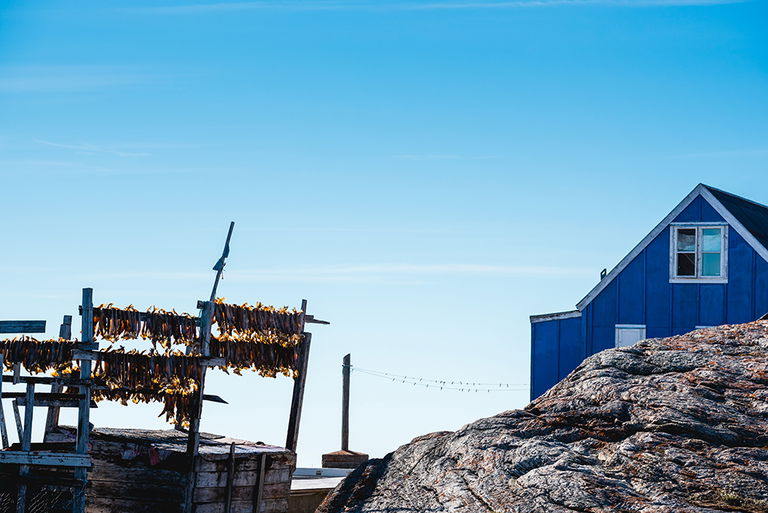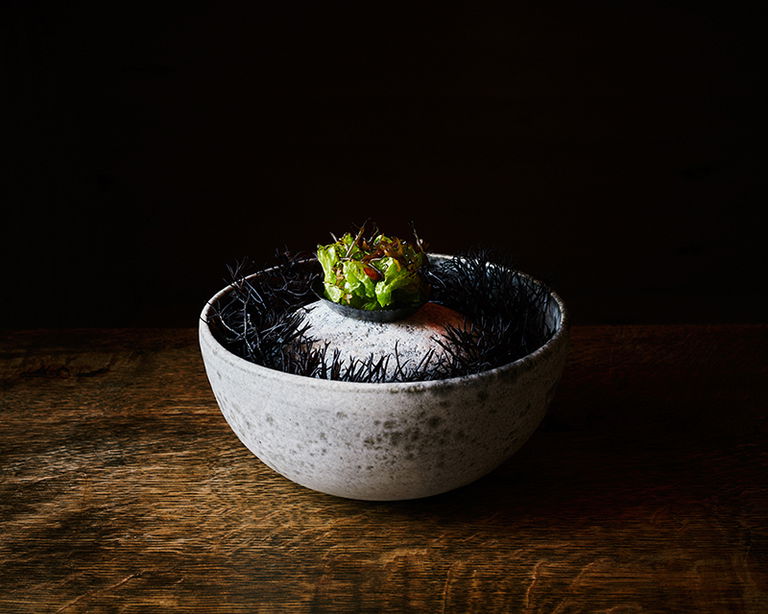Koks Transforms Greenland’s Unique Flavours into Culinary Art
30-year-old Nino Fjordside heads the test kitchen for the Faroese restaurant Koks, which is now settling into its final season in the remote Greenlandic settlement of Ilimanaq in Disko Bay. The stay has led to new discoveries in the test kitchen, including reindeer blood, whale fat, and fermented crowberries, now featured on the menu.
How do you incorporate distinctive Greenlandic ingredients like reindeer blood, whale fat, and seabirds into the menu of a two-star Michelin restaurant? This is the question that the Faroese restaurant Koks has been exploring for the past two years in Ilimanaq, a small, isolated settlement in Disko Bay, where the 55 residents have been joined by a two-star Michelin restaurant and a team of chefs and guests from around the world.
When summer season 2024 ends on 7th of September, Koks will do a three-week pop-up in Copenhagen’s Tivoli Gardens from 10th of October, featuring the best dishes from their three-year Greenland residency. Together, the final season and the pop-up mark Koks' final exploration of Greenland for the time being. One of the key figures in uncovering Greenland's culinary treasures is Nino Fjordside, who is responsible for Koks' test kitchen. During the Greenland project, his task has been to transform reindeer fat, whale, and seabird into flavourful, eye-catching dishes that still maintain a connection to Greenland. "Twisting the ingredients and evoking emotions in people – that's what I strive for. For me, the thrill is in the pursuit of bringing that out," says Nino Fjordside, 30.
A Focus on Fat
Reindeer fat is one of the successful experiments from the test kitchen that has made it onto the menu. In Greenland, reindeer fat – tunnoq – is considered one of the finest parts of the animal due to its high nutritional content. In the past, a diet rich in animal fat was essential for surviving the harsh winters here. Today, the fat is still a delicacy among the locals in Ilimanaq. They store it in the freezer and serve it year-round in a rather surprising way: the fat is cut into small squares and added to hot coffee, explains Nino Fjordside, who has taken a different approach. The test kitchen ages the fat in a mixture of salt and Greenlandic herbs – Arctic thyme and unripe juniper berries – resulting in Koks' own reindeer lardo.
We are quite enthusiastic about this reindeer fat, which has a deep, gamey flavour with a complex umami," says Nino Fjordside.
The kitchen slices the lardo thinly, torches it, and serves it on a sharpened ptarmigan wing along with grilled ptarmigan breast and oyster mushrooms, smeared with a purée made from, among other things, the crowberries found in the birds' crops before digestion.
Even reindeer blood, which the locals themselves find difficult to use, has been utilised by Nino Fjordside – as a dessert, no less. It began with a mistake when the kitchen whipped the blood into a dense foam using a Thermomix. It wasn’t intentional, but it led them in a new direction. After 57 attempts and two months, Nino and Koks sous chef Agnes Karrasch created a stable blood foam that retained a bright red colour and could be dried, cut out, and filled with fermented pears, malt caramel, and blackcurrants.

Young Chef with Development Responsibility
But how does one become head of research and development for one of the world's best restaurants at such a young age? Before Koks, Nino spent years working as a stagiaire around the world, including at L'Air du Temps in Belgium, L’Enclume in England, and Celler de Can Roca in Spain. After his time at the latter, he thought he had secured his dream job at Albert Adrià’s Enigma in Barcelona. But then COVID hit, and the world shut down. But not the Faroe Islands. Head chef Poul Andrias Ziska immediately offered him a job, and within a month, Nino Fjordside managed to get one of his dishes on the menu. He had used some of his days off to develop a petit four with caramelised elbow scales – a small mollusc found everywhere on shore stones in the Faroe Islands. Not long after, he and Ziska agreed in 2021 that Nino Fjordside should have his own development kitchen as Koks' Head of Research and Development. A remarkable privilege for a chef who has travelled the world in search of new learning and knowledge throughout his career. "I've always wanted to develop for a great restaurant. But before that, you must work your way up so that you understand the kitchen's language and nuances. But the classic kitchen hierarchy and that whole game don’t excite me much. I'm more of the nerd who stands out back," says Nino Fjordside.

A Woolly Sensation
In Greenland, he is involved in prep and service, but in the Faroe Islands, he runs his development kitchen in a former tuberculosis hospital in Torshavn. Here, he works on his many ideas and inspirations, some of which end up as dishes on the menu. For example, the dessert with lamb's wool, which has also made its way to Greenland.
The scent of wool is one of the most comforting things, and I started to wonder if that feeling could be brought into food in some way. That's what I find so exciting about cooking. You get an idea or an experience that you want to express. And then it's all about finding the right language to share it," he explains.
His idea resulted in a dish with a disc of set cream that had been steeped with lamb's wool. The cream is served with a juice of beets, rhubarb vinegar, and a compote of the small, black crowberries that grow as shrubs right outside the door in Ilimanaq.

Short Seasons Challenge Logistics
In the 1700s, Ilimanaq served as a whaling station and trading centre for Danish and Dutch whalers, and Koks’ seasonal residency is in the 275-year-old, black-stained wooden house that overlooks the icebergs in Disko Bay, and formerly belonged to Danish merchant and missionary Poul Egede. The facilities don’t allow for a separate development kitchen, so much of the fundamental development work is done in the Faroe Islands. Greenland's short seasons, limited infrastructure, and vast size have also been a challenge, Nino Fjordside explains. "It's been quite a mission," he says, explaining how the logistical puzzle of securing enough of the right ingredients has been one of the biggest challenges overall. "Here, we can't just go out and gather ingredients like we do in the Faroe Islands. But in a way, that's also working with nature. You gather the few things that are there – when they're there."

5 Other Fantastic Greenlandic Flavours According to Nino Fjordside
Whale Skin and Blubber (mattak): "The whale skin from minke and narwhals has a deep, nutty flavour and an almost MSG-concentrated aftertaste. The skin releases more and more flavour as it's chewed. The blubber isn’t fishy in taste but has a greenish, slightly floral note in the nose. Truly an impressive experience. Last year, we served both skin and blubber raw on the first dish of the menu, where we folded the skin around the blubber and brushed it with a smoked sugar kelp glaze and blackcurrant leaf oil."
Deep-Sea Shrimp: "Greenland's cold environment is clearly reflected in the shellfish, which have a great natural sweetness and a texture far superior to shellfish from warmer regions. I never expected to feature shrimp as the star of a dish on the menu, but then, we tasted them straight from the boat. Last year, we served them raw in a milk skin tartlet with fried shrimp heads and a shrimp bisque with coal-infused shrimp oil, burnt cream, shrimp and rosehip garum, and quince vinegar."
Rose Root: "An Arctic root used in traditional Greenlandic medicine, where it’s preserved in whale fat. Inspired by this, we made a cream with fermented rose root, mussel juice, blackcurrant leaf oil, and whale fat. The fermented root tastes like a mix of horseradish and rosehip leaves and has a perfumed, green, and leafy note on the nose."
Capelin (ammassat): "A small fish, 10-15 centimetres in length, caught from a boat by pouring yogurt into the water. The yogurt tricks the females into thinking there’s fish semen nearby. They can then be hauled up by the thousands in just a few minutes. When the fish are alive, they have a very distinctive cucumber scent. It’s crazy. The locals dry them and use them mainly for dog food. But last year, we served them salted and pickled whole, filled with cream of roasted lettuce, flambéed sake, and spruce juice."
Bog Labrador: "A wild herb that tastes like a mix of rosemary, lavender, and mint. It's very perfumed and has a cooling effect in the mouth. We’ve used it, among other things, with sorrel to make a wonderfully vibrant juice."
Don't miss out!
Sign up now for our newsletter.












